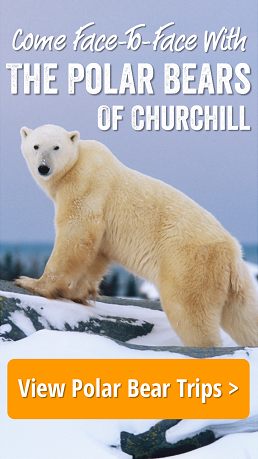by Steve Selden | Oct 23, 2011 | Tour News
A cold, snowy and windy start to the week has jump-started the season and eclipsed last year’s slower start. More of an Arctic-like start than last year. The temperature drop has allowed the rain to become snow creating a more northern feel. Polar bear numbers have been slowly rising both in the Churchill Wildlife management area and in Churchill proper.Seems like momentum is building for another unique, exciting month of wildlife encounters.
Natural Habitat guide Elise Lockton and group observed a sow and her cub out at Bird Cove and then made their way over to the tundra lodge on their evening rover excursion. The usual suspect larger bears lounged around the willows behind the lodge while the group enjoyed some wine and a nice meal on the tundra. The previous day the group was out near Gordon Point where a dead seal went undetected by a polar bear that actually circled the area twice…must have had a cold or something. Numerous Brant Geese flying as well as multiple common eiders filled out the sub-arctic landscape.

Polar bear in the willows. Paul Brown photo.
A “great” day on the tundra ,as guide Colby Brokvist put it, began with polar bears at bird cove, Halfway Point and the spit of land extending bay-ward near the lodge. Though mostly lounging and snoozing along the Hudson Bay coast, the setting itself is simply unforgettable for travelers who have never experienced this landscape. A warm, very sunny and clear day with a cold Northerly wind made roving the tundra even more glorious. It was also “fantastic” for bird sightings as the late migration pattern is holding on for a little longer. The group watched eagerly as a pure- white gyrfalcon chased snow buntings around along the coast. Another pair of glaucous gulls, a female black scoter, and a common goldeneye were also present for all to check off their life-lists. Goldeneyes will Winter as far North as open -water permits so they may be around for a good while this Fall. Continuing down the Christmas Lake esker past an old inuit hunting camp out by the coast revealed some additional bird life. Some red breasted mergansers, a couple of black-bellied plovers, a white- rumped sandpiper and a large flock of rock ptarmigan kept the binocular -wielding birders busy. Ubiquitous ravens and snow buntings abounded all day. Along the launch road heading in, a sub-adult polar bear emerged from the willows nose in the air. It crossed the parked shuttle bus on the road and began cleaning its’ coat on the patchy snow just on the other side. Then, black -tipped snout in the air, it began walking towards town….the group followed along the road. Nice escort.

Conservation officers preparing polar bear for airlift. Paul Brown photo.
A bear evacuation coordinated by Department of Natural Resources(DNR) and Hudson Bay Helicopters originally scheduled for 10:30 AM on October 19th turned into a 3 PM lift instead due to DNR being preoccupied with a rogue polar bear in town. Eventually a good sized crowd outside the bear compound near the airport was thrilled to see a sow and cub loaded and transported Northward. I have seen numerous “bear-lifts” in my time in Churchill and they are always an awesome experience. Seems like bear season is in full swing now.

Polar bear in net being airlifted north. Paul Brown Photo.
by Steve Selden | Oct 19, 2011 | Tour News
The town of Churchill, Manitoba voted yesterday by a margin of 58% -42% to end the process of artificially fluoridating it’s drinking water supply. The three -year campaign by a group called Churchill No -Fluoride culminated with the victory in the town-wide plebiscite. Mark Brackley the founder and driving force behind the grass-roots initiative began this quest three years ago and was ecstatic with the result. In a Facebook posting from Churchill mark expressed his gratitude to all who supported the choice; “I want to personally thank all of you who came out for your health, you are amazing people that have decided to take back your power of choice. I’m proud of you Churchill. You have made history.”

Fluoride is bad!!!
With the vote finished, the results will now be in the hands of city council and they will most likely set a date for the official end to the fluoridation process. Go to the Churchill No fluoride page on Facebook for reactions from local Churchillians and further information on the issue. (more…)
by Steve Selden | Oct 18, 2011 | Tour News
Natural Habitat guide Karen Walker didn’t have to wait long for her group of travelers to see what they had come to Churchill for. On their first tour to the tundra, a night rover excursion, the group spotted a polar bear in the distance. The excitement grew during a five-minute drive that brought the tundra rover within a couple of hundred yards of the animal. In awe, as they watched for about 20 minutes, many on board could not believe the calmness of the bear. Moving ahead after seeing another bear in the distance, they came upon a polar bear laying over the top of the caribou carcass, discovered earlier in the week, just about two hundred yards away. Another 15-20 minute drive farther and they sighted another very large bear. It stood for the group to get a good look at it then relaxed itself down amongst the willows. So, within the first two hours out on the tundra, the group had encountered three polar bears! Not a bad start to the expedition up North. During an impromtu birthday celebration for one guest aboard the rover, the entourage was greeted by some scattering willow ptarmigan on the tundra as well as an Arctic fox nosing around perhaps looking for a slice of cake itself.

ChurchillPolar bear shaking off the rain. Matt Goddard photo.
The following day as the group headed out to the Churchill Wildlife Management Area (CWMA), they sighted the two bears they had seen the night before. In the afternoon, while situated in a spot to view the polar bear devouring the caribou they actually viewed the bear ripping flesh off of the caribou. Another occurrence that I cannot remember seeing or hearing about in twelve years of being involved with Churchill polar bears. There’s always something new happening each season.
Later on in the day the group rumbled out toward the coast past first tower and ptarmigan alley near the flats. Karen noted that the colors of the grasses & seaweed were “very, very beautiful.” Golden yellows, deep rust, red, browns, and black. Tundra colors in the Fall are a landscape artist’s dream. The group saw a few bears out there as well though none of those animals were very accessible for the rover. However, as this season has been offering, the travelers were fortunate once again to spot some more ptarmigan, then an arctic fox chasing snow buntings, and an Arctic hare in its’ white winter coat attempting to hide up against a brown willow bush. Um..not such great camouflage. The group was also treated to a display of two dark-colored juvenile gyrfalcons chasing after a snow bunting. Swooping past the rover several times, all the while changing directions attempting to catch their prey, the aerial dog-fight maneuvers emerged in and out of the patches of fog thrilling all eyes down on the rover.
On the groups final day excursion to the tundra in the CWMA, the first two bears had vanished. With not much but a pile of bones remaining from the caribou carcass, a few ravens were mopping up the last leftovers. Moving North to Halfway Point Karen’s group of traveler’s sighted a nice-looking bear on the beautiful coastal rocks with the Hudson bay stretched out behind. This large male put on a good show, rolling around with his huge paws flailing up in the air. After napping he teased the group by lifting his head every once in a while just to keep watch on the suspicious looking machine with giant wheels.
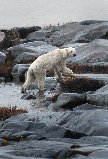
Matt Goddard photo.
After this incredible encounter, the rover headed along the Inland Trail searching for caribou, but had little luck with the elusive ungulates. Soon after a flock of about 100 snow geese were visible on the tundra …a somewhat rare sight the past couple of seasons. Despite their abundance in prior years, hardly any were spotted this past Summer. This flock might have arrived in late Summer and stayed out farther to the East. Karen noted that about two-thirds of the flock were in the blue- color phase. These birds are surely an amazing Arctic sight to take in when amassed in large numbers.
Finally, the highlight of the trip for the guests was out on the coastal lowlands to the East. An adult male bear walking along the coast spooked a five-year-old female polar bear and she began trotting away from him. She was splashing through the shallow ponds just a couple hundred yards away from the rover. Brendan, the rover driver/guide parked in a perfect spot, and eventually she walked up toward the vehicle, coming within only 30 feet. She then walked back and forth a few times, sniffing at the air and staring right into the astonished eyes of the Arctic travelers. Everyone was able to get a excellent look at one of the North’s finest creatures.
On the last day, the wind picked up tremendously inciting enormous waves to crash along the shores of Hudson Bay. White sea- foam accumulated along the rocks looking like ice chunks from afar. The mist & rain continued much like almost the entire trip. Just going outside was quite an adventure and fortunately the temperatures remained bearable. The group took a ride out to the weir along Goose Creek road and spotted a couple of river otters in a tributary along the way. for a few brave souls, climbing to the top of the weir observation tower in the frenetic wind was another highlight of the trip…good old sub-Arctic gales. A fitting finale to a most adventure -packed trip!
Today, October 18th, Churchill is voting to determine whether or not they will continue to add fluoride to their drinking water. Voting is 11-8 today and I’ll give you the results first thing tomorrow as well as another update. Stay tuned…should be an exciting result.
by Steve Selden | Oct 15, 2011 | Tour News
Southerly winds and scattered rain amongst the lowland fog accentuated the landscape out on the tundra in the Churchill wildlife Management Area. Temperatures in the mid to higher 30’s C gave the air just enough crispness to enliven the sighted polar bears. A wide range of Arctic wildlife complimented the bears as well with numerous sightings reported.
This time of year, in the early Fall season, many creatures in the North start or already have morphed their furry coats to white even though the snow has not arrived. The biological clock controlling the morphing is more dependent on the time of year than the weather. Polar bears of course keep their white look all year…others like Arctic Fox, Arctic Hare, ptarmigan, snowy owls and some other birds do make the change to a coat that will blend with the forthcoming snow. For now however the animals are more easily spotted out on the tundra.
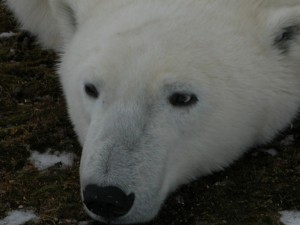
Guide Melissa Scott escorting her Natural Habitat group out over the wet, foggy tundra came across their first polar bear quite near the rover launch area munching on a caribou carcass by himself…quite the find for the bear and the travelers literally right out of the gate. Another two bruins were sighted out near the coast road and another slightly more inland rolling on his back playing with a spruce twig. a few other bears were spotted lazily napping in the willows trying to shield themselves from the weather.
Four Arctic foxes were spotted congregating around the rover and actually staying near the machine feeding on various tid-bits of foliage and ground fodder. This behavior was a little out of the ordinary for the normally slightly skiddish foxes…at least in the presence of a giant rover with 16 or so humans inside. As the group headed back toward the tundra lodge inside of the coast road an Arctic hare with a soggy white coat scampered through the brush along the trail near ptarmigan alley. As they finished up an afternoon of good viewing, A big male bear greeted them as the rover pulled up to the tundra lodge. All in all a great day!
Guide Eric Rock had similar varied wildlife sightings as his group roamed around the CWMA in their tundra rover. Arctic fox and hare were spotted and photographed and an initial gyrfalcon soared overhead. A half dozen bears were spotted and by and large (yes large) the animals were reported to be in good shape despite the late freeze-up of the Hudson Bay last season.The most healthy polar bear was the one still devouring the caribou carcass near “lunch-site”…er sorry launch-site.
This year, not just this season, there have been 180 bear alert calls. As of this date there are currently nine bears in the polar bear compound.
by Steve Selden | Oct 13, 2011 | Tour News
Doesn’t quite seem like a year has passed since last bear season. Maybe all the bear activity this past Summer and Fall has kept them in the forefront of our thoughts..kind of like Spring or Summer training for the numbers expected for is October/November in Churchill.
The early season had the seniors group in Churchill, accompanied by Dene elder Caroline Bjorklund, out on a tundra rover trip in the Churchill Wildlife Management Area (CWMA). The group had a beautiful day on the land and saw a healthy male bear out by the Great White Bear tundra lodge. The big male seemed healthy and in good shape. The sentinel bear hopefully will portend a season of exciting polar bear behavior and good, robust animals.
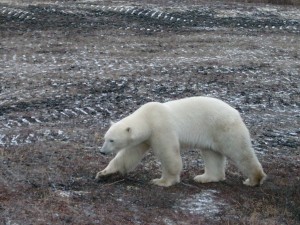
Polar bear on the tundra.
Churchill is currently under a wild sideways blowing rainstorm with temperatures hovering above the freezing mark. This also could be a sign of some frenetic weather for the upcoming season. Early October is usually fairly calm and uneventful on the weather front. We’ll see how this first storm turns out and if it turns into any of the white stuff. Sled dogs as well as mushers across the Churchill region are waiting with baited breath for a possible early sledding season.
The first official tour group of the season was out on the tundra just a few days ago and the numbers of bears already have escalated. Eight males and sub -adults were spotted over the course of the day and a happy group ventured back to town with exciting stories of the North. The season is just underway though the prospects for seeing good numbers of polar bears seems positive. News from the tundra lodge with be forthcoming..can’t wait to hear what’s going on out there!
The vote by Churchill residents to possibly eliminate the process of adding fluoride to their water is less than a week away. Many towns throughout multiple provinces in Canada have taken these steps…we’ll see how it goes soon. We will keep you posted.
by Steve Selden | Sep 22, 2011 | Tour News
As early October creeps closer, thousands of travelers from across the globe prepare for the trip of a lifetime. Many have anticipated this experience to immerse themselves in the polar bears’ habitat for months if not years. This experience in the small town of Churchill, Manitoba on the shores of the Hudson Bay will for some forever change the way they look at the world and the animals that inhabit it. All who make the one-week or so venture will remember it forever.
Another group of people take a slightly different view of the forthcoming season. Seasonal workers by the hundreds also come to Churchill for a seven -week period for the incredible experience. The town becomes a community and network of people all working toward the same goal of helping others enjoy one of the most unique “migrations” of sorts on the planet. Many of these workers come back, year after year, mixing with other newbies looking for an adventure. In a way the workers that return to Churchill every year are quite like the polar bears..all reuniting with the same purpose.
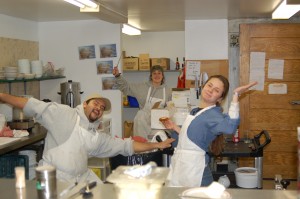
Seasonal workers in Churchill stay loose.
As the season grows closer, I know from over 10 years of experiencing the season, that along with the anticipation of the amazing events over the two-months, one also has intense feelings of angst on either end of the season and waves of high and low energy spurts as the season blooms into full-swing. Preparing for this flow can be more critical then the ability to handle the workload and long hours ahead throughout October and November. A tremendous energy reserve is necessary for a person to work virtually every day for almost seven weeks straight. Rewarding and taxing at the same time, emotions of every kind are constantly tapped. Year’s of experiences are often condensed into this time-frame and it may take just as long to process.
“Teams” of workers meld as the season goes on. Restaurants, tour companies, hotel staffs, rover companies, conservation officers and on and on work together to not only serve clients at a high level of excellence but also to aide each other in surviving the long season. There’s no choice in this situation…you have to become proficient and highly skilled in what you are offering or the operation will fall apart. There can be no middle ground. Efficiency rules in such a small town with limited resources. Waste of any sort cannot exist.
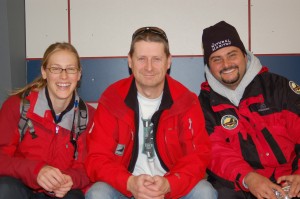
Another Churchill polar bear season ends with smiles.
As the season comes to a close, many will need to use reserve energy to finish as strong as they started. Once the season does end, one’s body will release all the tension and pressure built up over the past seven weeks and it will take up to two weeks to recharge. First, all the energy left will be let go and then the slow recharging will take place. Often this all takes place back in civilization of a much different sort and “culture shock” can be very slow to overcome as well. About six months down the road everyone is once again slowly building that anticipation of the season until all of a sudden it’s here again. In many ways this process goes on in each of us in some way with regards to so many things in life.











